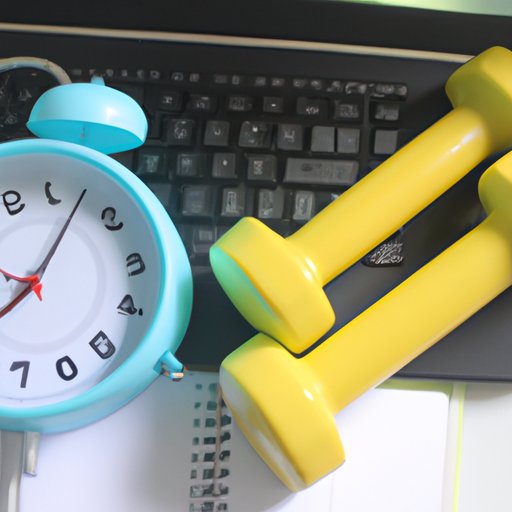
Introduction
Many people struggle with the question of how long to wait before exercising after eating. The answer is not simple, as it depends on various factors, including the type and size of the meal, the time of day, and individual metabolism. In this article, we’ll explore the science behind waiting before exercising after eating, as well as strategies for timing your workouts around meals to maximize performance, balance energy needs, and achieve your fitness goals.
Science Explains Why It’s Best to Wait Before Exercising After Eating
When we eat, our bodies go through a complex digestive process to break down food into nutrients that can be absorbed and used for energy. During exercise, the body requires energy to power its movements, and this energy comes from the stored glycogen in the muscles and liver.
If you exercise too soon after eating, your body may still be digesting the meal, diverting blood flow away from the muscles and causing discomfort or cramping. Additionally, exercising before digestion is complete can cause changes in blood sugar levels, leading to fatigue and lightheadedness.
To avoid the negative effects of exercising too soon after eating, it’s best to wait at least an hour after a light meal or up to three hours after a large meal before engaging in moderate to intense exercise.
Maximizing Your Workout: Timing Your Exercise Routine Around Mealtimes
Timing your workouts around mealtimes can help you maximize performance and prevent discomfort. For morning workouts, it’s best to eat a light, carbohydrate-rich meal such as fruit, toast, or yogurt at least 30 minutes to an hour before exercising to provide the body with energy. For evening workouts, it’s important to avoid heavy meals that can slow digestion and cause discomfort. A light snack such as a banana or a protein shake consumed about an hour before exercising can provide energy without weighing the body down.
In general, aim to wait one to two hours after eating before engaging in moderate exercise, such as jogging, swimming, or cycling. For more intense activities such as weightlifting or high-intensity interval training (HIIT), wait at least two to three hours after eating a full meal to avoid discomfort.
Should You Exercise Before or After Eating? A Guide to Optimal Workout Timing
The decision of whether to exercise before or after eating depends on individual factors such as metabolism and fitness goals. Exercising on an empty stomach can enhance fat burning and weight loss, but it can also lead to lower energy levels and decreased performance. On the other hand, eating before exercising can provide energy and fuel for the workout, but it may lead to discomfort or cramping if the time between eating and exercising is too short.
To determine the optimal timing for your workouts, consider the following:
- The type of exercise: Low-intensity exercise such as yoga or walking may not require as much pre-workout fuel as high-intensity activities like weightlifting or sprinting.
- Your individual metabolism: Some people may need more time to digest food before exercising, while others may be able to exercise sooner after eating.
- Your fitness goals: If weight loss is a priority, exercising on an empty stomach may be beneficial. However, if building muscle is your goal, eating before exercising may be preferable.
Fueling Your Body: How to Determine the Perfect Window Between Eating and Exercise
Determining the ideal window between eating and exercise requires a balance of energy needs, digestion, and exercise performance. Some general tips to consider include:
- Listen to your body: Pay attention to how you feel during and after exercise to determine if you need to adjust your timing strategy.
- Experiment with timing: Try different pre-workout meals and wait times to find what works best for you.
- Stay hydrated: Drinking water before, during, and after exercise can aid digestion and prevent cramping.
Ultimately, the perfect window between eating and exercise depends on individual factors and may take some trial and error to determine. Some people may need to wait longer after eating, while others may be able to exercise sooner without discomfort.
The Importance of Proper Nutrition and Exercise Timing: How to Enhance Your Workout Performance
Proper timing of nutrition and exercise can enhance performance and support overall fitness goals. Eating a balanced diet that includes carbohydrates, lean protein, and healthy fats can provide the fuel needed for workouts and aid in recovery. Timing meals and snacks to coincide with exercise can ensure that the body has the necessary energy for optimal performance.
Additionally, planning exercise around mealtimes and individual needs can enhance comfort and prevent discomfort, allowing individuals to work out harder and longer. By finding the optimal balance between nutrition, exercise, and timing, individuals can achieve their fitness goals and enjoy a more effective and enjoyable workout experience.
Conclusion
Although there is no one-size-fits-all answer to the question of how long to wait before exercising after eating, considering individual factors and following some general guidelines can help maximize performance, prevent discomfort, and achieve fitness goals. By timing workouts around meals and considering individual needs, individuals can enhance their exercise experience and enjoy the many benefits of a healthy and active lifestyle.
We hope this article has provided you with valuable information and tips for timing your workouts for optimal performance. We encourage you to experiment with different timing strategies and pay attention to your body’s cues to find what works best for you.




